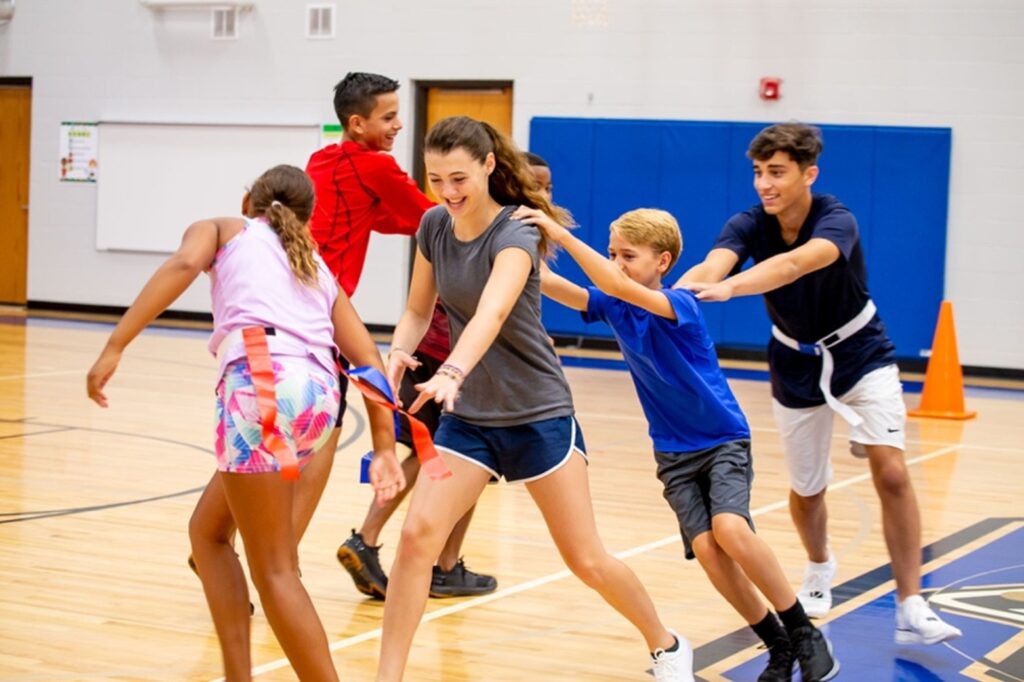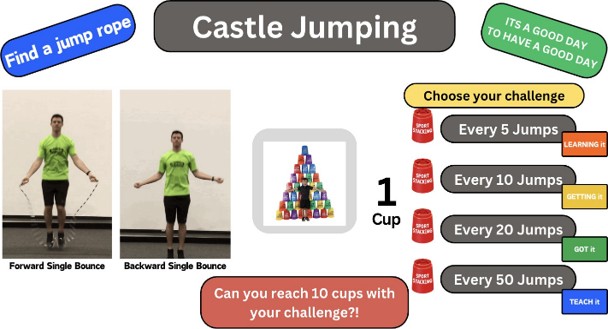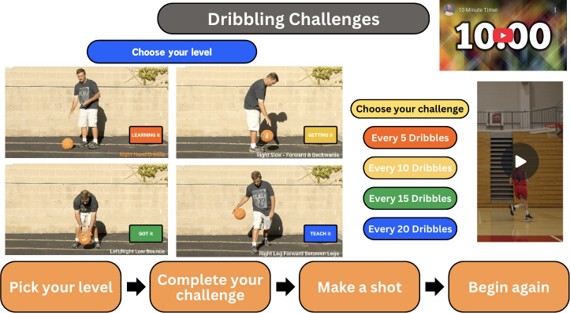Instant activities don’t just fill time, they play a powerful role in shaping the success of your physical education classes. Instead of losing valuable minutes to transitions, waiting for instructions, or classroom management, instant activities ensure that every student is moving, learning, and engaged from the very first moment they step into the gym. These short, purposeful bursts of activity set the tone for the entire lesson: students enter with energy, teachers can establish routines smoothly, and the whole class starts on the right foot.

Beyond simply “getting the wiggles out,” instant activities are a teaching strategy that maximizes activity time, fosters skill development, and supports both learning and classroom management. They can be adapted to fit any space, class size, or equipment availability, and most importantly they make PE fun and engaging for kids of all ages.
In this post, I’ve outlined 8 unique benefits of using instant activities, along with limited to no equipment activity examples for each. Whether you’re looking to increase movement, reinforce skills, or just start class with excitement and focus, these strategies will help you make the most of every minute in PE.
1. More Movement, Right Away
Students walk in, drop their belongings in the designated spot, and jump right into movement. Instant activities cut down on wasted time, boost activity minutes, and set a focused, energetic tone for class. Clear expectations are important to help students transition smoothly and keep the lesson running efficiently.
Examples:
Cone Grab: (Equipment: cones)
Scatter cones around the gym. Students jog to grab one cone at a time and bring it to a designated spot.
Dribble & Move: (Equipment: basketballs or soccer balls)
Each student grabs a ball and dribbles around the gym. Add variations like right hand only, left hand only, or alternating feet.
Locomotor Laps: (Equipment: none, optional poly spots for marking pathways) Students choose a locomotor skill (skipping, galloping, sliding, jogging) and move around the gym until called together.
2. A Fun Start to Class
Instant activities hook students with something playful right from the start to capture their attention and energy. A fun challenge, silly movement, or quick game immediately sparks curiosity and excitement. This positive momentum sets the tone for the rest of the day’s activities.
Examples:
Mirror Movement: (Equipment: none)
Students pair up; one leads with creative movements, the other mirrors. Switch after 30 seconds.
Animal Walks: (Equipment: none)
Call out animals (bear crawl, crab walk, frog jump, kangaroo hops). Switch animals often to keep interest high.
Music Freeze (Equipment: music)
Students move around the gym (jog, hop, skip) while music plays. When it stops, they freeze in a silly pose.
3. Smooth Classroom Management
Instant activities keep students engaged and moving while you manage the transition from one class to the next. Because students are already active, you can take attendance, set up equipment, or connect with individuals without losing momentum. This smooth flow ensures every class starts organized and on-task.
Examples:
Whiteboard/Screen Tasks: (Equipment: whiteboard/marker or projector)
Write “Do 20 jumping jacks, then jog 2 laps.” Students read and self-start.
Station Start: (Equipment: cones, jump ropes, beanbags, hula hoops)
Place small challenges at each cone: jump rope 20 times, balance on one foot, toss/catch a beanbag, hula hoop for 10 spins. Students pick a station to begin, then switch after 30 seconds to 1 min.
Find a Spot: (Equipment: poly spots)
Students enter, find a spot, and perform a simple task like hopping, balancing, or jogging in place. Using a screen, writing on the whiteboard or using cone sign holders can help provide direction.
4. Build Skills Without Them Even Realizing It
Instant activities can be designed to reinforce skills students have already learned, giving them extra practice in a fun, low-pressure format. They can also introduce
simple variations that extend those skills, challenging students to apply them in new ways. This playful approach keeps learning fresh while building confidence and mastery.
Examples:
Partner Toss: (Equipment: beanbags, foam balls, or yarn balls)
Students pair up and count how many successful toss-and-catches they can do in 60 seconds.
Dribble Tag: (Equipment: basketballs or soccer balls)
Everyone dribbles while trying to tag others. If tagged, players do a quick exercise before rejoining.
Balance Challenges: (Equipment: none or panel mats)
Students hold poses (tree, airplane) for as long as possible. Add challenges like “balance while clapping 5 times.”
5. Warm-Up Without the Boring Factor
These activities get students moving right away, helping their bodies warm up naturally through play and exploration. Because they feel like fun games rather than a typical warm-up, students are more motivated and engaged. This playful approach prepares them physically and mentally for the main lesson without losing their excitement.
Examples:
Around the World RPS: (Equipment: cones to mark boundaries)
Students begin in one corner and find a partner to play rock, paper, scissors. The student that wins travels to the next corner. Repeat until completing a circle.
Fitness Dice: (Equipment: large foam dice, or make your own with a box)
Each number represents an exercise (e.g., 1 = squats, 2 = push-ups, 3 = jumping jacks). Roll and the whole class does the move. If you have enough dice, each student or students in pairs can complete the activity.
High-Five Hunt: (Equipment: none)
Students walk, skip, or jog around the gym and see how many high-fives they can give in 1–2 minutes.
6. Quick Check for Understanding
Instant activities can serve as a quick check for understanding, allowing you to observe how students apply skills in a low-stakes setting. As they play, you can note
strengths, spot misconceptions, and identify who may need extra support. This informal assessment helps guide instruction while keeping students active and engaged.
Examples:
Jump Rope Challenge: (Equipment: jump ropes)
Students see how many consecutive jumps they can complete. Watch for technique and stamina.
Target Toss: (Equipment: beanbags, hula hoops, buckets, or taped floor targets) Students toss beanbags into marked targets. This could be played as a “Make it, Take it” game or students could track their score on a pop-it, use cubes, popsicle sticks or money.
Alphabet Workout: (Equipment: none)
Post letters; each corresponds to a movement (A = 10 jumping jacks, B = 5 squats, etc.). Students spell their names.
7. Adaptable for Any Group
Instant activities are highly adaptable, making them effective whether you’re teaching a large group, a small class, or working with tight space and minimal equipment. They can be modified with simple variations to match the environment and resources available. This flexibility ensures every student stays active and engaged, no matter the setting.
Examples:
Follow the Leader: (Equipment: none)
One student leads locomotor moves; the group copies.
Imagination Walks: (Equipment: none)
The teacher calls out scenarios while the students try to complete the challenge: “Walking through quicksand,” “Climbing a mountain,” “Swimming through water.”
Zone Activities: (Equipment: cones, poly spots)
Divide gym into zones: Zone 1 = jogging, Zone 2 = balance poses, Zone 3 = strength moves. Rotate every minute.
Scarf Toss: (Equipment: none)
Each student tosses and catches a scarf or tissue, practicing hand-eye coordination without risk of injury.
8. Most of All, They’re Fun!
When students laugh and play right from the start, it creates a positive atmosphere that makes them eager to participate. This early burst of fun builds excitement and sets a welcoming tone for learning. As a result, students carry that motivation and engagement through the rest of the lesson.
Examples:
Dance Party: (Equipment: music player)
Play a 1–2 minute upbeat song. Students freestyle or copy your moves.
Direction Dash: (Equipment: none)
Teacher calls out cues: “Forward!” “Backward!” “Side shuffle!” Students respond by changing direction quickly.
Shape Maker: (Equipment: none)
Teacher calls all out shapes (triangle, star, letter). Students use their bodies or groups to form them.
Follow the Beat: (Equipment: none)
Teacher claps a rhythm, while students copy with jumps, stomps, or claps.
Click these images for links to more examples of Instant Activities
Summary
With well-designed instant activities, educators can maximize instructional time by engaging students in meaningful movement immediately upon entering the classroom. These activities not only facilitate smooth transitions and reduce classroom management challenges
but also provide opportunities to reinforce essential skills in an enjoyable and effective manner. Moreover, the majority of these activities require minimal equipment, relying instead on clear routines and consistent implementation to create a positive and productive learning environment.











